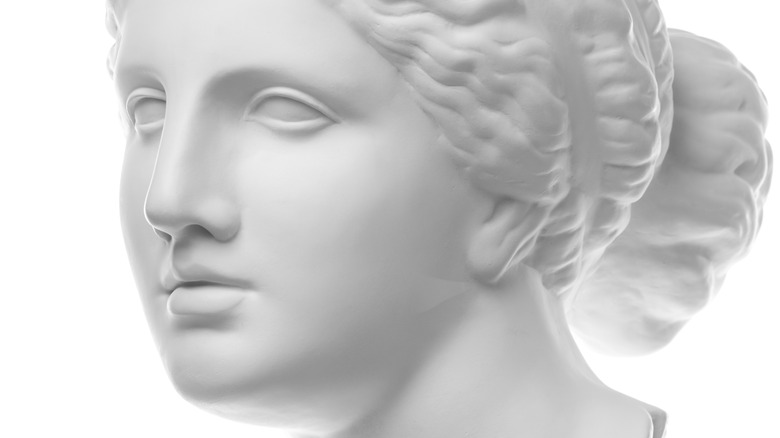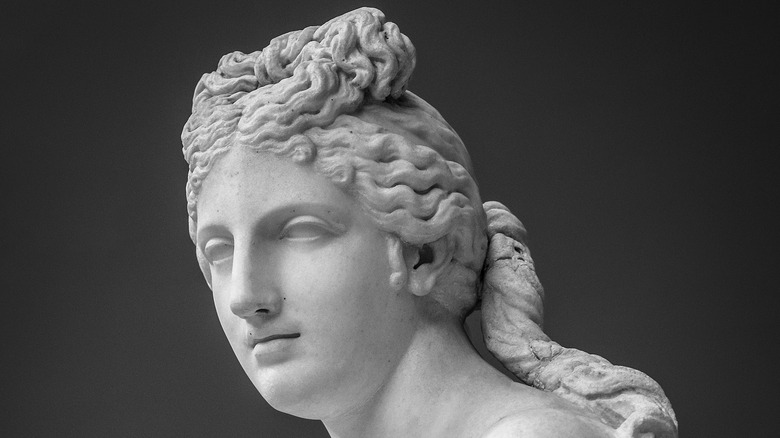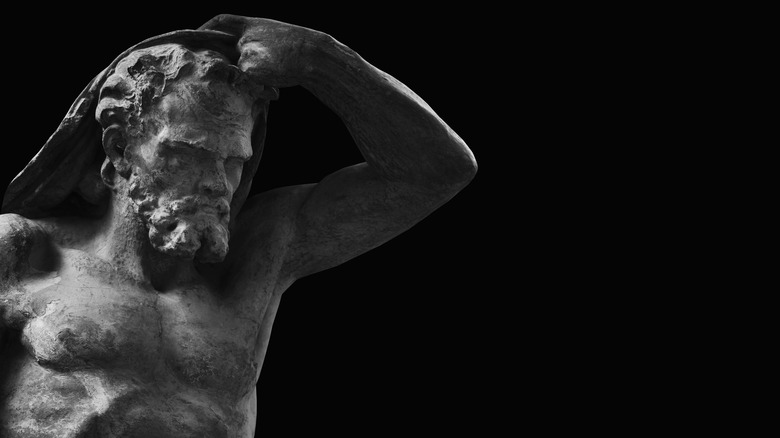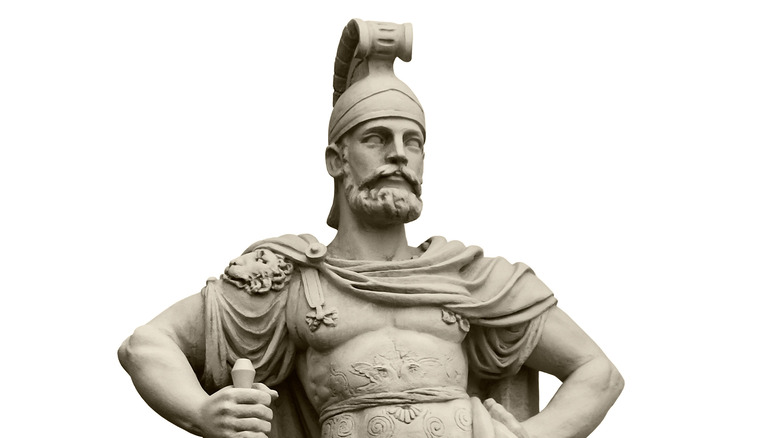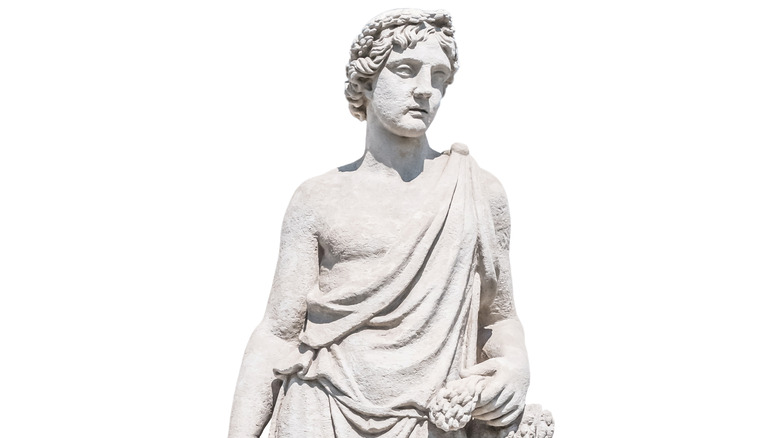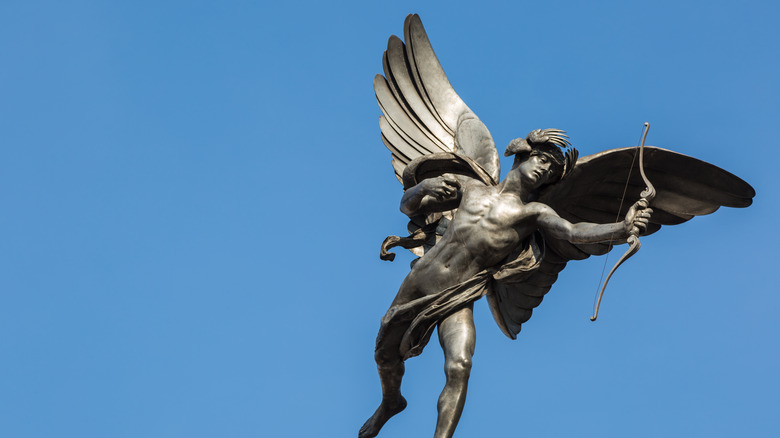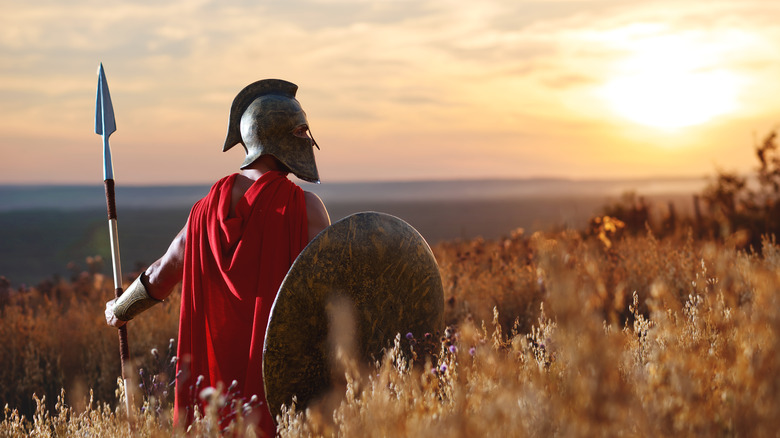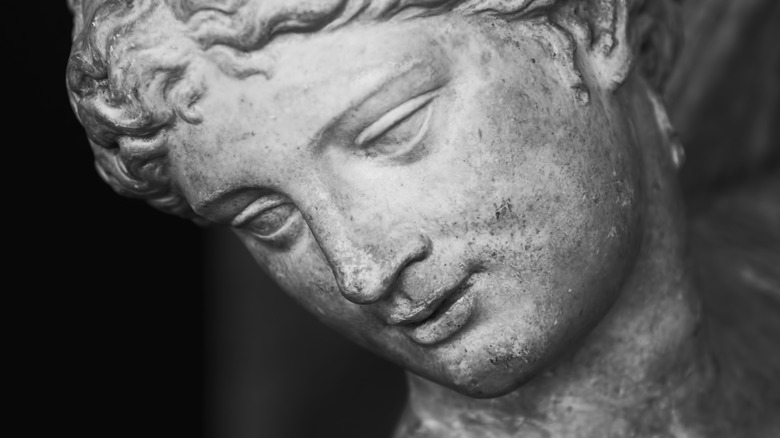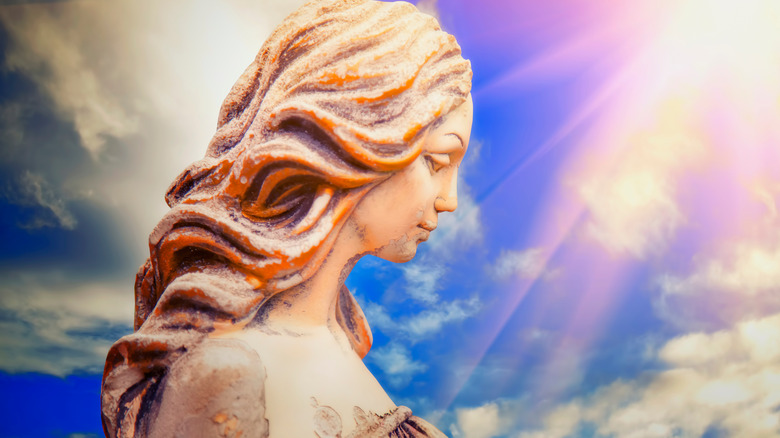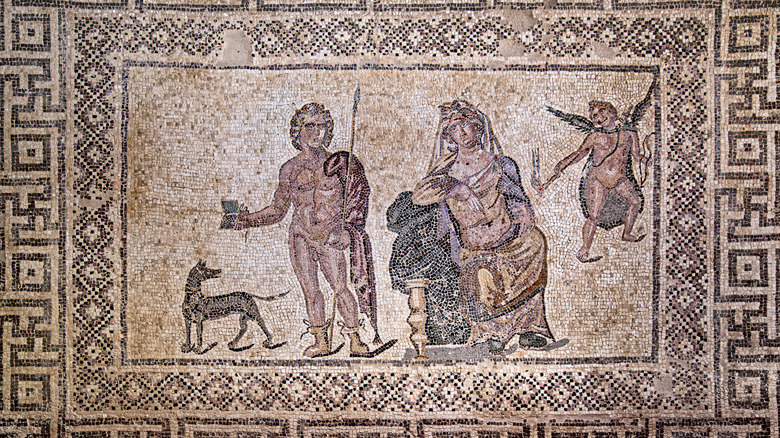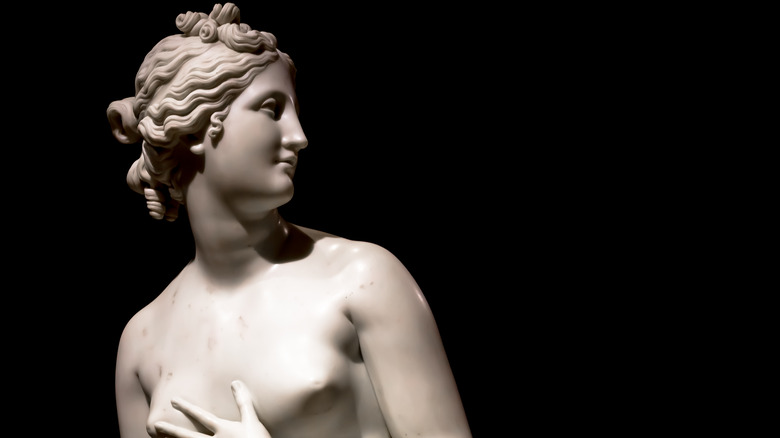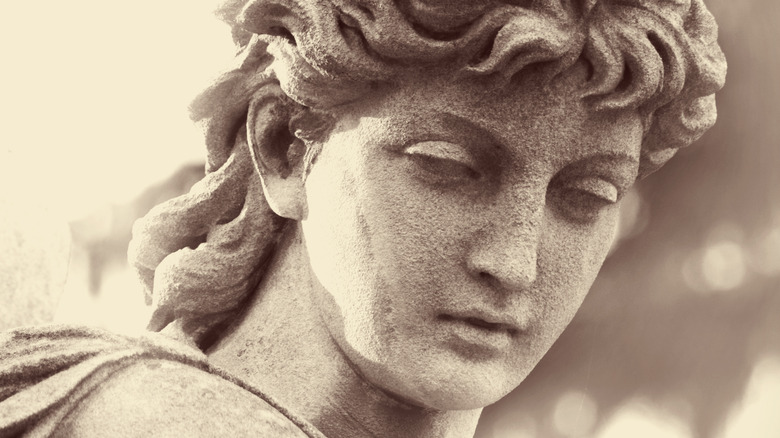The Mythology Of Aphrodite Explained
Aphrodite was the ancient Greek goddess of love, sex, desire, and beauty, and one of the 12 gods of Olympus, alongside Zeus, Athena, and Hermes. In Roman mythology, she was known as Venus. Aphrodite easily seduced those around her because she was gorgeous, and both men and women worshipped her. However, Aphrodite was also very vain, and was jealous of mortals and other goddesses who also happened to be good looking.
Aphrodite took revenge against those who crossed her, and she had dalliances with many mortals and gods even though she was married. She was the inspiration behind some of the world's most famous pieces of art, and she was partially responsible for staring a major war in Greek mythology. Aphrodite may have been beautiful, but you didn't want to mess with her. Check out some interesting facts about one of Greek mythology's most famous figures.
Aphrodite was the goddess of love and sex, and the patron deity of sex workers
If there's one goddess from Greek mythology that oozes love and sexuality, it's Aphrodite. She represented beauty and desire, and was able to seduce both gods and mortals, who were smitten by her good looks and sex appeal. In addition to being the goddess of love, Aphrodite was the patron goddess of sex workers. In ancient times, people erected numerous temples to honor Aphrodite the Courtesan, Aphrodite of Brothels, Aphrodite of Streetwalkers, and so on, according to Hooker Heroes. These temples were tended to by priestesses who worshipped Aphrodite.
The hetairae were female companions and courtesans who took part in ceremonies honoring the gods. One of these hetairae, Phryne, would celebrate the end of the religious rites known as the Eleusinian Mysteries by doing a striptease in front of the temple. Phryne was also the headliner at the festival of Poseidon and Aphrodite by reenacting Aphrodite's birth. She would remove her clothing, jump into the water, and "sacrifice" herself to Poseidon. Then she would return to the temple as a sea nymph, goaded on by the crowd.
Aphrodite was either the daughter of Zeus or emerged from the sea fully grown
There are two origin stories connected to Aphrodite. In the first one, she simply appears out of the ocean as a fully grown woman. She does not have a mother, but her father is Uranos, the god of the sky, according to Ancient Origins. Uranos ruled as king alongside his wife, Gaia, the goddess of Earth. Zeus would not appear to take his place as king of the gods for two generations. Uranos was not a good dad; he hid his children far inside the Earth because he hated them.
Gaia, who despised her husband, plotted with her son Cronus to trick Uranos. She gave Cronos a sickle, and when she and Uranos started to get intimate, her son cut off Uranos' genitals, which fell into the sea. The genitals were covered in sea foam, and Aphrodite rose from the foam. The Greek word aphros translates to "foam," hence Aphrodite's name. It may refer to sea foam or to Uranos' semen. However, some scholars believe Aphrodite existed prior to ancient Greek times, and that her birth story was developed as a result of her name, according to GreekMythology.com.
Another origin story claims Aphrodite was the daughter of Zeus and a goddess named Dione, of which there is not much information. Greek poet Homer preferred this version of Aphrodite's birth, and he included the goddess in both of his famous poems, "The Iliad" and "The Odyssey."
Aphrodite's husband was the lame and ugly Hephaestus
You would think a goddess as beautiful and sensual as Aphrodite would have a husband who was also attractive, but this was not the case. Just like Aphrodite, Hephaestus was one of the 12 Olympians. He was the god of fire and smiths, as well as sculpture and carpentry. Zeus and Hera were his parents, but he was ugly, which set him apart from the other Greek gods, who were absolute perfection (or nearly so). Some myths also note that Hephaestus was lame, an injury that may have been caused by Zeus or Hera, according to Ancient Origins.
In one version, Hera threw her son off Mount Olympus because she was disgusted by his appearance. When Hephaestus was able to make his way back up the mountain, he sought revenge by tricking his mother. He built her a golden throne, and she was unable to release herself from it because invisible rope kept her in place. Dionysus, who helped Hephaestus get back to Mount Olympus, convinced him to free his mother. But before he did, Zeus asked Hephaestus to free Hera. Taking advantage of the situation, Hephaestus said he would free his mother if he could marry Aphrodite. That sealed the deal. Another myth has Zeus marrying off Aphrodite to Hephaestus because he didn't want the other gods to fight over her, according to Sword Temple.
Aphrodite had a torid affair with Ares
Like many of the gods, Aphrodite wasn't faithful, and had affairs with other gods and mortals. It wasn't difficult for her to find a lover because she was beautiful and difficult to resist. In addition, she wasn't happy about marrying Hephaestus because he was ugly, according to Exploring Your Mind. Even though Hephaestus tried to win her over by creating extraordinary jewelry for Aphrodite, she wasn't interested. Instead, she cavorted with other gods and men.
In contrast to Hephaestus was Ares, the god of war. He was a symbol of male virility and was very attractive. When he met Aphrodite, he was instantly smitten. He wooed Aphrodite with presents and appealed to her vanity by bestowing her with compliments. Before long, they became lovers. They kept their romance a secret from Hephaestus. The problem wasn't that Aphrodite was having an affair, because this practice was common among the Greek gods and goddesses. The problem was that she had just one lover over an extended period of time.
Eventually, Hephaestus found out about the relationship. He made a web of gold threads that captured the lovers on their bed. Hephaestus then called all the gods and goddesses to witness their betrayal before releasing them.
Ares killed Adonis, an object of Aphrodite's affection
While Aphrodite enjoyed being with Ares, he wasn't the only man in her life. She also had a thing for Adonis, who has an origin story involving incest. Adonis' mother was Myrrha (also known as Smyrna), while his father was King Cinyrus of Cyprus, who also happened to be Myrrha's father. Adonis was born because Aphrodite was jealous of Myrrah's beauty and she set it up so the girl would have sex with her father. When he realized, Cinyrus was outraged and tried to kill his daughter and their unborn child. Feeling guilty, Aphrodite saved Myrrha by turning her into a myrrh tree, according to Greek Myths & Greek Mythology.
Aphrodite eventually set her eyes on Adonis, which angered Ares. Aphrodite wanted to have sex with Adonis, but he preferred hunting, which worried her. She knew that the sport was dangerous and warned him to give it up. Adonis didn't listen, and was killed during a wild boar hunt, which was orchestrated by Ares. After his death, Aphrodite held Adonis, and his blood dripped onto the earth, turning into anemone, which became a symbol of their love.
Aphrodite had several children
Aphrodite had relationships with a lot men, including Adonis, Anchises, Ares, Butes, Dionysus, Hermes, Phaeton, Phaon, and Poseidon, according to Soft Schools. As a result, she also had several children, such as Aeneas, Anteros, Deimos, Eunomia, Eros, Eryx, Harmonia, Hermaphroditos, Himeros, Phobos, Priapus, Pothos, and Rhode. Most of her offspring, however, were fathered by Ares. Her children were known as daimones, or minor gods. Eros, or Cupid, is the most well known, and there are many myths about him, the Greek god of love, according to Mythology Source.
One of Aphrodite's sons, Aeneas, was mortal. He fought in the Trojan War and was one of the founders of Rome. Two other sons, Deimos and Phobos, took on characteristics of their father Ares and represented fear and dread. They went to battle alongside Ares. Aphrodite and Hermes had a child named Hermaphroditus. He embodied both male and female attributes and was the patron deity of intersex individuals and effeminate men. Some myths tell that Aphrodite and Dionysus had a son named Priapus, the fertility god, who was popular in Rome.
Since her children were minor gods, there are not many stories or legends about them (except for Eros). They each represented emotions, and those with negative connotations were associated with Ares, while those involving love were associated with Aphrodite.
Aphrodite was one of the three goddesses whose feud caused the Trojan War
Aphrodite had a sister named Helen, whose husband was the King of Sparta. While Aphrodite was beautiful, Helen was also attractive, according to Ancient Greek Myths for Kids. Aphrodite was incensed when she found out that a prince from Troy named Paris declared that Helen was more beautiful than anyone else. In a related event, during a wedding reception, Eris, the sister of Ares and personification of disagreement, was angry because she was not invited to the marriage celebration, so she threw an apple on the table, proclaiming that it was meant for the fairest one in the land.
The goddesses Aphrodite, Hera, and Athena each tried to take the apple. Zeus intervened and declared that Paris would make the decision. Each of the goddesses tried to persuade Paris to choose her as the loveliest. Paris was not particularly smart and could have simply chosen them all. Instead, he told the goddesses that he'd make a decision based on who provided the best bribe.
Aphrodite told Paris that she could make his brothers jealous by getting Helen, the Queen of Sparta, to fall in love with him. Paris liked the idea and picked Aphrodite as the fairest. Little did Paris know that he sealed his fate. Aphrodite enchanted Helen so she would leave Sparta with Paris and move to Troy. The King of Sparta was furious and wanted his wife back, so he organized an army with other Greek kings, which started the Trojan War.
Aphrodite had a magical girdle
Hephaestus was thrilled to be married to the beautiful Aphrodite, so he showered her with gifts. Since he was the god of fire and smiths, he had the ability to make her fancy jewelry and other accessories. One of these was a strophion, or girdle, according to Sword Temple. This type of clothing consisted of cord or a strip of leather that was placed over the shoulders, under the arms, and around the waist according to Hellenica World. It was designed to emphasize the wearer's breasts.
Naturally, a goddess like Aphrodite wearing this type of accessory would be hard to ignore. The girdle even had a magic power: it made gods and men powerless in its presence and made them only think of love and desire. According to How Stuff Works, Aphrodite had no problem lending the girdle to Hera, so she could divert Zeus' attentions from the Trojan War. Hera, the goddess of marriage, also used the girdle to help feuding spouses fall in love again, according to Theoi.
Aphrodite had loyal companions who stuck by her side
Aphrodite had attendants or companions who spent time with her. One of these companions was her son Eros, the god of love. Eros is often pictured as an attractive man or winged cherub who carries either a bow and arrow or a lyre, according to Greek Gods and Goddesses. He personified love, sex, athleticism, and art. As his mother's companion, he is often depicted as a chubby child with wings, particularly in Roman mythology. There are many myths involving Eros, who is also known as Cupid. One negative fact about Eros is that he had a penchant for using his arrow haphazardly when it came to love.
Himeros was another one of Aphrodite's attendants. He had wings like Eros and stood for romantic love and romantic attraction, according to Helinika. Pothos (passion) and Peitho (political persuasion and romantic persuasion/seduction) were also Aphrodite's attendants. Roman mythology portrayed Aphrodite's attendants as winged babies, while Greek mythology depicted them as youthful adults.
Aphrodite made Hippolytus' stepmother fall in love with him
Artemis, the goddess of chastity, the hunt, the harvest, the moon, and childbirth, was the daughter of Zeus and Leto. Several myths recount how Artemis exacted revenge against mortals who crossed her, according to Greek and Roman Mythology. However, she wasn't the only goddess who sought revenge against those who didn't see things the way she did. The Athenian tragedy "Hippolytus" by Euripides recounts how Aphrodite and Artemis clashed over a man named Hippolytus and the tragedy that resulted.
The first problem was that Hippolytus devoted his allegiance to Artemis. This was difficult for Aphrodite to accept because she didn't like those who ignored her beauty and power, according to GreekMythology.com. Hippolytus rejected anything to do with Aphrodite and wouldn't worship her or even recognize her as a god. This enraged Aphrodite, so she decided to get back at Hippolytus. She arranged things so that his stepmother, Phaedra, fell in love with him. As expected, this resulted in a pretty terrible scenario. Phaedra would up killing herself, while Hippolytus was cursed by his father and died violently. This all occurred because Aphrodite couldn't accept that Hippolytus worshipped Artemis instead of her.
Aphrodite inspired more works of art than anyone else in classical mythology
Sculptors and other artists loved using Aphrodite as their subject, and she is depicted in classical artwork more than any other figure, according to Oxford University Press. One popular theme involves Aphrodite's birth. For example, the version in which Zeus and Dione are her parents is featured on a pediment on the front of the Parthenon. She was also popular in paintings. Two paintings by Antoine Watteau show Aphrodite ruling Cythera.
Largely depending on the era, Aphrodite was portrayed either clothed or nude. One of the most famous sculptures of Aphrodite is the Venus de Milo, in which the lower part of her body is covered in draping. François Boucher produced several masterpieces with Aphrodite in them. She is also pictured in Titian's "Sacred and Profane Love" and is the subject of the Venus of Cnidos statue by Praxiteles. More recently, John Singer Sargent's 1910 "Breakfast in the Loggia" painting shows a statue of Aphrodite behind two women having a meal together.
People still worship Aphrodite today
It wasn't just the ancient Greeks who worshipped Aphrodite. A Russian immigrant named Gleb Botkin created the Church of Aphrodite in 1938, according to Sword Temple. The details about this neopogan religion are included in the book "In Search of Reality," which was published in 1969. The book explains that Aphrodite was portrayed a little differently in this religion than she was in Greek mythology. She was viewed as the sole goddess in this monotheistic religion instead of just one god among many. Sword Temple says that the book also claimed "that the worship of Aphrodite had been brought to Greece by the mystic teacher Orpheus, but that the Greeks had misunderstood Orpheus's teachings and had not realized the importance of worshipping Aphrodite alone."
Aphrodite is also an important figure to some Wiccans. When practitioners are dealing with love and romance, they often speak Aphrodite's name during rituals. To them, Aphrodite represents emotion, erotic spirituality, art, and creativity. Aphrodite is also included in the neopagan religion known as Hellenic Polytheistic Reconstructionism or Hellenismos. This religion tries to replicate the type of religion that those in ancient Greece followed.
